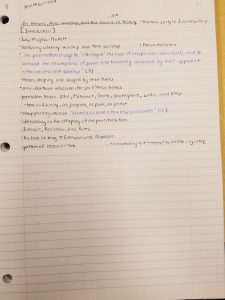The book I am starting with for my research on heroes is On Heroes, Hero-Worship, and the Heroic in History ( 2013) by Thomas Carlyle with essays by a number of contributors. I chose this work to start because the title repeatedly popped up on preliminary theoretical resource searches. After reading the introduction, I know why: It argues and explores what has been termed the “Great Man” theory (i.e., history is defined by great men).
Although I think it could still be beneficial to read thiswork for my research, I don’t think it’s best to right now. The introduction provided a good overview of what Carlyle’s lectures contain, and at this point that’s all I really need from the book. That said, my next step will probably be to read Comic Books and American Cultural History: An Anthology. I need to wade around in comic book history and cultural before progressing into the modern-day superhero franchise (while engaging with more theoretical texts along the way).
As for my notes, I have uploaded a photo of them because I take notes best the old-fashioned way: by hand. I find that I retain what I read way better when I do so, and it keeps all of my notes (apart from supplement materials–which I keep, in addition to my notebook, in a research binder) together.

You’ll notice that I use different colored ink; I use blue ink for direct quotations and black ink for general notes, that way when I am going back through my notes I can pull quotes easily. You might also notice that my pages are numbered; my high school chemistry teacher taught us to treat notebooks much like books with table of contents and page numbers, and this method has helped keep my pages-upon-pages of notes organized and navigable. I also have the habit of writing key words in the left-hand margins of my notes, and major concepts in the upper margins. If a note or quote is particularly important, I star it. Section headings or chapters I put in brackets, and I always put the title and year of what I am reading along with author(s) on top of the first line of every corresponding page, often with (continued) in parenthesis if the notes area continuation of the same work.
